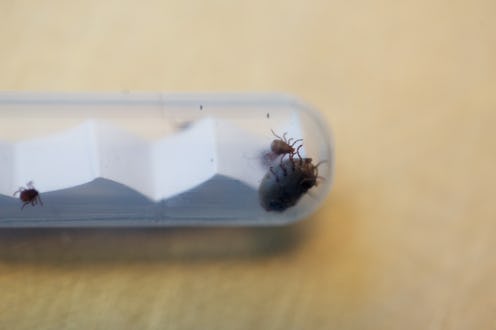Life
People In These States Are More Likely To Be Affected By Ticks Causing Meat Allergies

Reports of the lone star tick (the tick famous for causing an allergy to red meat and dairy) spreading upward and outward from the Southeast, to the Northeast and Midwest are everywhere this tick season. And if you're anxiously wondering where lone star ticks live, you've likely read the horror story-like reports of the tick's alleged nationwide takeover. But while these ticks' whereabouts are definitely worth being aware of, according to one tick expert, the epidemic-like alarmist stories are a bit exaggerated — and the areas where you'll find the lone star tick are pretty well-defined.
According to Chuck Lubelczyk from the Maine Medical Research Center for Lyme and Vector-Borne Disease while speaking to Bustle, though the tick has been spreading, there doesn't seem to be an actual trend just yet. "Despite looking for an increased population of the lone star tick, we just haven't found it — yet." But, as many readers have seen, reports of the lone star ticks migrating from the southeast regions of the United States to the northeast regions are painting a different story. So, what's the truth? Should people in states like Vermont and Maine be worried?
Simple answer: No, they shouldn't be worried. But then again, people in states like North Carolina, where the lone star tick population is abundant, shouldn't be worried either. According to Lubelczyk, there are a few things that have affected the public's perception of the lone star tick. First, there's awareness: people are now more aware of the tick, so they're looking for it. Second, Lubekczyk tells Bustle, there's misidentification: the American dog tick (which is typically harmless on the Northeast) looks mighty similar to the lone star tick (they both have a small, single white spot on their back), and that tick has become much more prevalent in the last few years.
And finally, there are travel-related cases: people are from the Northeast are taking trips to the Southeast, where the lone star tick is abundant. Often by the time people realize they have been infected, they're already home, so they get diagnosed there. This leads to confusion about where the tick is actually living.
Additionally, birds who have taken pit stops in the Southeast may very well be taking with them lone star ticks, only to drop them off on the Northeast during their spring migration. These factors lead to more findings of the tick but not certifiable population establishments. Which also explains something that a lot of people might be curious about.
In 2011, the Center for Disease Control and Prevention (CDC) mapped out the span of lone star tick findings — but, fast forward to 2017 and the map is essentially identical. According to Lubelczyk, the CDC's map only shows "established populations" meaning, not rare findings or small increases, only ecological abundance. And, as of now, the Northeast does not consider their lone star tick findings to be abundant.
The warm and wet southern states on the East Coast are most likely to find the lone star tick roaming around, because that remains the most established popular environment for them. As far as the Northeast: Rhode Island, coastal Massachusetts, Connecticut, and interior New York are also seeing rising abundant populations of the lone star tick, though it's not an established epidemic yet.
The lone star tick's bite can trigger an intolerance to alpha gal — a sugar complex found in hooved animal products — and, it can carry Ehrlichiosis — a bacterial infection that causes miserable flu-like symptoms in humans. That said, even though headlines might be suggesting that the tick-triggered allergy to red meat is increasing, Lubelczyk isn't convinced. "People are more concerned about ticks now, they're doing more tick checks and as a consequence, the number of ticks people are finding is going up," Lubelczyk explains. Plus, now that allergists are aware of the correlation between the lone star tick and the alpha gal intolerance, they're testing for it more. The more they know to test for it, the more cases they find. This doesn't necessarily mean that there's any kind of real increase just yet, it just means there's an increase in its documentation.
But as for population changes in Maine, New Hampshire and Vermont, there's no tick apocalypse happening — yet. Though, Lubelczyk says that "yet" is really the keyword. Milder winters and increases in population of the white-tailed deer, which is the lone star tick's favorite host, can and will increase and expand the tick's reach in the U.S. "Talk to me in 10 years," Lubelczyk warns, "we might have an established population of lone star ticks in Maine by then."